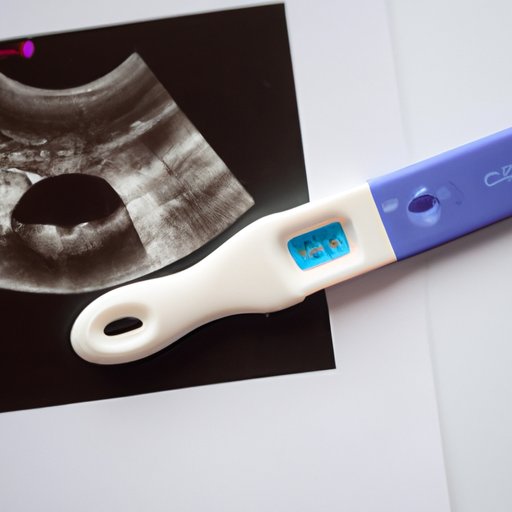Introduction
For many people, the question “How early can I test positive for pregnancy?” is one of the first that comes to mind when considering starting a family. Whether you’re eager to confirm a suspected pregnancy or just curious about your fertility, early pregnancy testing can provide valuable information. In this article, we’ll explore the different timelines and methods for testing for pregnancy, as well as the potential emotional ups and downs that can come with waiting for test results. By the end of the article, you’ll have a better understanding of how to navigate the confusing and often anxiety-inducing world of pregnancy tests.
The Earliest Signs of Pregnancy: How Soon Can You Test Positive?
One of the first things to understand about early pregnancy testing is the typical timeline and symptoms of early pregnancy. While everyone’s experience is different, many women begin to notice signs of pregnancy as soon as a few weeks after conception. These can include missed periods, breast tenderness, nausea, and fatigue. As for when you can actually test for pregnancy, it depends on the testing method and your own individual circumstances. Some of the most common testing methods include at-home pregnancy tests, blood tests, and ultrasounds.
In terms of accuracy, most at-home pregnancy tests become reliable around the time of your expected period, roughly two weeks after ovulation. Blood tests and ultrasounds can often detect pregnancy even earlier, sometimes within a week or less after conception. Of course, it’s important to read the instructions carefully and follow them closely to ensure the most accurate results possible. If you get a negative result but still suspect you may be pregnant, wait a few days and test again, or talk to your healthcare provider.
Putting Pregnancy Tests to the Test: What You Need to Know About Early Testing
When it comes to early pregnancy testing, understanding the science behind different tests can be helpful in making informed decisions. At-home pregnancy tests work by detecting levels of the hormone human chorionic gonadotropin (hCG) in your urine. These levels typically rise rapidly in early pregnancy, making it a reliable indicator of pregnancy. Blood tests also detect hCG but can often provide even earlier results since they are more sensitive than at-home tests. Ultrasounds use sound waves to create images of the fetus and surrounding structures, allowing healthcare providers to identify a pregnancy as early as a few weeks after conception.
While many pregnancy tests are reliable, it’s important to understand that different products have different sensitivity levels and accuracy rates. For example, some at-home tests can detect hCG at levels as low as 20 mIU/ml, while others require levels upwards of 50 mIU/ml. Reading reviews from other users and doing research on specific products can help you select a test that is both reliable and suited to your unique needs. Additionally, following test instructions closely and avoiding common mistakes such as testing too early or waiting too long to read results can improve accuracy.
The Emotional Rollercoaster of Early Pregnancy Testing: Coping with the Wait
For many people, the days or weeks between taking a pregnancy test and receiving results can be anxiety-inducing or stressful. It’s important to acknowledge the emotional rollercoaster that can come with early pregnancy testing and to take steps to cope during this time. Strategies that can be helpful include practicing self-care, such as getting enough sleep and engaging in activities that bring you joy, as well as seeking support from loved ones. Being mindful of your mental health and reaching out for professional support if needed can also be helpful.
Beyond the Basics: Unusual Factors That Can Affect Early Pregnancy Test Results
While most people will find pregnancy testing to be a straightforward process, there are certain situations in which accuracy can be affected by external factors. For example, if you are undergoing fertility treatments or taking certain medications, it’s important to discuss these factors with your healthcare provider, as they can impact test results. Additionally, taking a pregnancy test too early or too late in your cycle, or not following instructions for a particular testing method, can result in inaccurate results. When in doubt, it’s always best to consult with a healthcare professional.
Navigating the Confusing World of Pregnancy Tests: Which Brands and Types Are Right for You?
With so many different pregnancy tests on the market, it’s important to understand the pros and cons of each type and brand. Some of the most common types of tests include digital tests, strip tests, and midstream tests. Digital tests use words or symbols to indicate whether you are pregnant or not, while strip tests and midstream tests typically rely on lines or colors to display results. The type of test that’s right for you will depend on your individual preferences and circumstances, as well as the sensitivity and accuracy of the product you select. Reading reviews and comparing different products can help you make an informed decision.
Conclusion
Overall, early pregnancy testing can be a valuable tool for understanding your fertility and confirming suspicions of pregnancy. While it can be a confusing and emotional experience, taking steps to understand your options and cope with the wait can make the process easier. By staying informed about the science of different testing methods and selecting high-quality products, you can feel more confident in your results. If you have any concerns or questions, don’t hesitate to reach out to your healthcare provider for guidance and support.
(Note: Is this article not meeting your expectations? Do you have knowledge or insights to share? Unlock new opportunities and expand your reach by joining our authors team. Click Registration to join us and share your expertise with our readers.)
